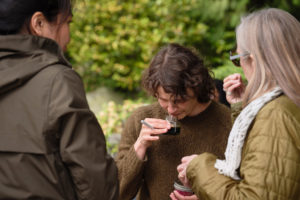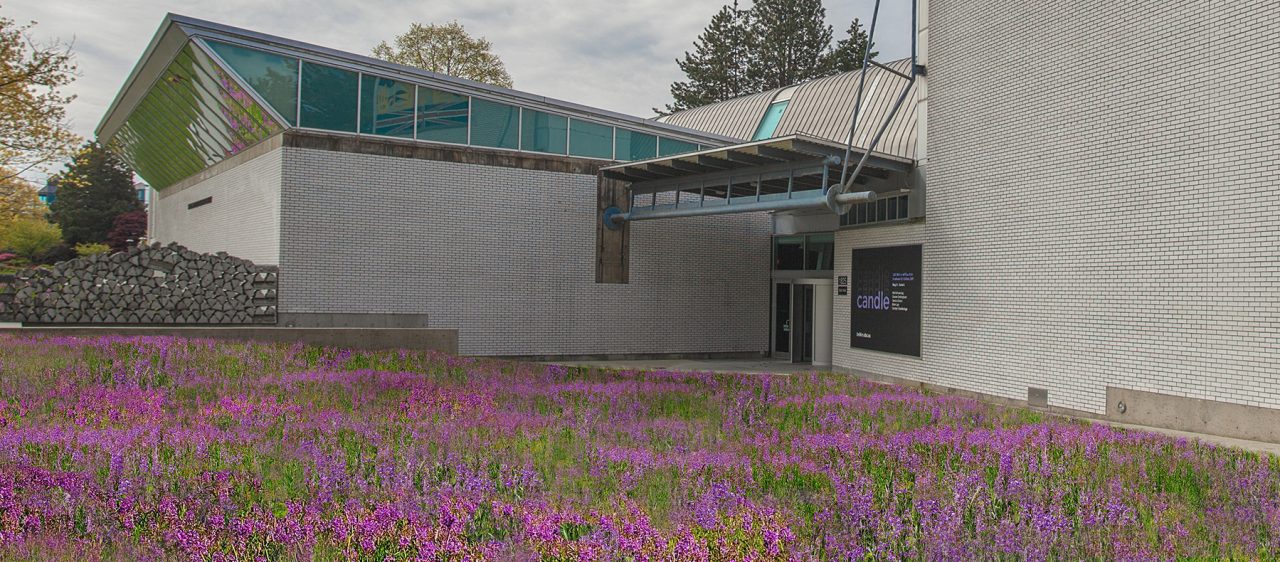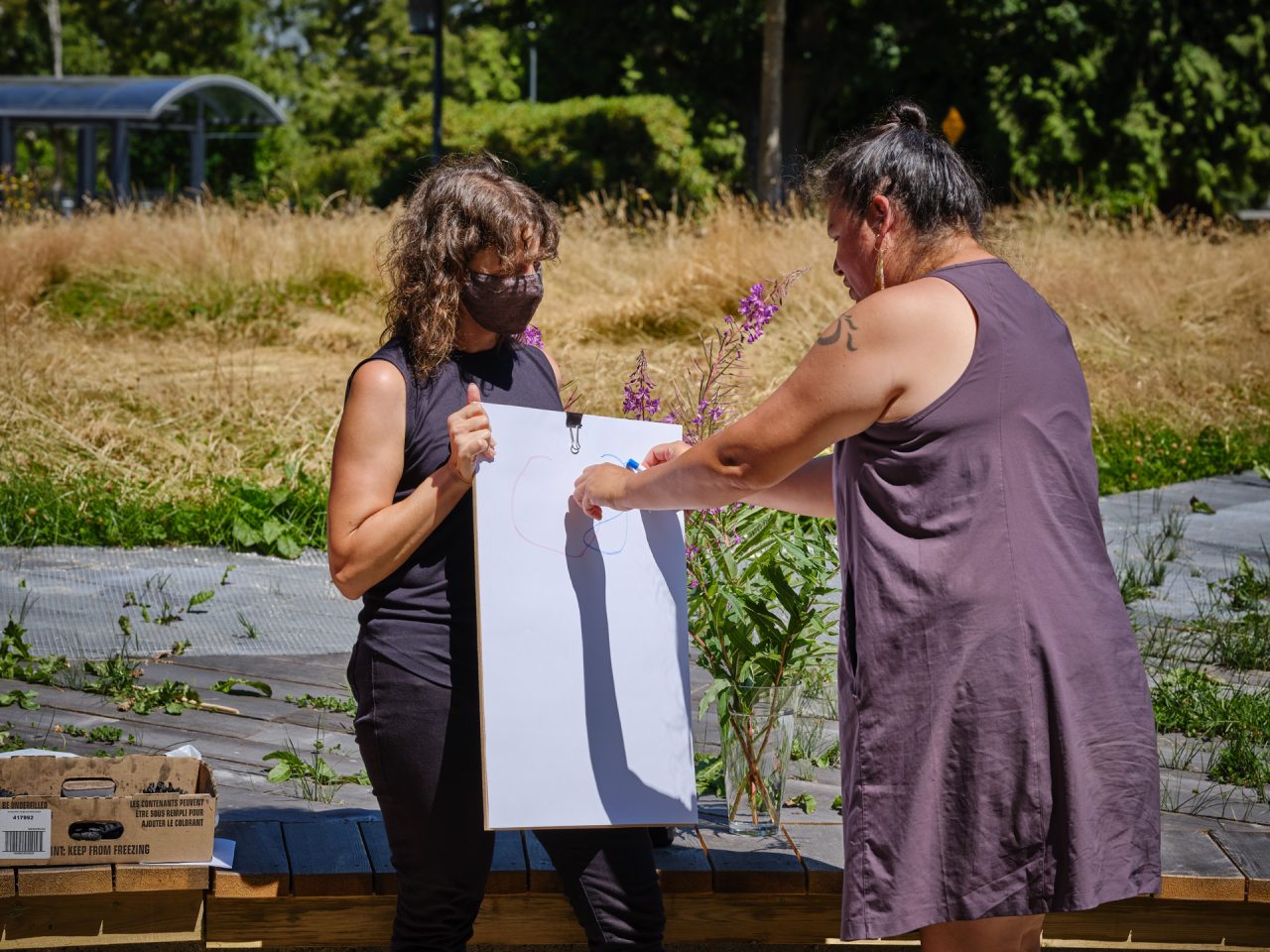17 Sep 2022
Holly Schmidt’s Fireweed Fields: Summer Intensive 2022
With the Fireweed Fields grassy meadows in front of the Belkin serving as a site for gathering and reflection, Holly Schmidt invited researchers and artists to come together for two full days in July 2021 and again in June 2022 to slow down and meet across disciplines. It presented a dedicated time to engage in creative experimentation that focused attention to learning from plant life. Both Intensives included moments of organized walks, sensory exercises and discussion as well as time for independent creative work and reflection.
 Schmidt’s intent was to provide space and time for participants to reflect upon some of the most pressing issues of our time. With sensorial exercises designed to hone our ability for attentiveness, we left feeling better equipped for a level of caring that exceeds beyond our individual needs. We were reminded that to effectively face the current climate emergency, it requires a deep commitment to collaboration and respectful consideration of expertise from multiple perspectives and areas of study.
Schmidt’s intent was to provide space and time for participants to reflect upon some of the most pressing issues of our time. With sensorial exercises designed to hone our ability for attentiveness, we left feeling better equipped for a level of caring that exceeds beyond our individual needs. We were reminded that to effectively face the current climate emergency, it requires a deep commitment to collaboration and respectful consideration of expertise from multiple perspectives and areas of study.
2021 Participants: Claudia Krebs, Michelle LeBaron, Linda Nowlan, Natalie Purschwitz, Genevieve Robertson, Daisy Rosenblum, Marina Roy, Rena Sharon, Chrystal Sparrow, Jay White and Rita Wong.
2022 Participants: Xinwei Che, Barbara Cole, Claudia Krebs, Sara MacLellan, Linda Nowlan, Natalie Purschwitz, Rena Sharon, Sheryda Warrener, Jay White, Rita Wong and Reyhan Yazdani.
Reflection: In Search of Lost Time
By Julia Trojanowski
This title is a bit misleading. The Fireweed Fields Summer Intensive 2022 was less about searching for lost time and more about grappling with the time we do have and the conditions we share. As it does in Proust’s famous passage, scent-memory wove an important thread through the words exchanged over the course of these two days. The embodied recall of a place and time, intensified by the direct route to the amygdala and hippocampus that scents tend to take, opens up a world of previously concealed associations.
 We started with the scent walk, a rainy excursion to the wooded area adjacent to Nitobe Garden. With small jars containing clippings of local plants, each member of the group found a spot in which to spend some time reflecting and interpreting its scent. Short poems, prose pieces, conversations and sketches found their roots in this meditation. My catnip, for instance, was a reminder of the cupboard in which my parents kept tea, where the scent of stale herbs, cedar and honey mingled.
We started with the scent walk, a rainy excursion to the wooded area adjacent to Nitobe Garden. With small jars containing clippings of local plants, each member of the group found a spot in which to spend some time reflecting and interpreting its scent. Short poems, prose pieces, conversations and sketches found their roots in this meditation. My catnip, for instance, was a reminder of the cupboard in which my parents kept tea, where the scent of stale herbs, cedar and honey mingled.
(If the sense of smell took centre stage this particular summer, last year’s workshop highlighted sound: though of course, we rarely use one sense to the exclusion of all others. A “visual score” produced in Nitobe Garden, to the soundtrack of birdsong, human voices, lapping waves and passing cars, opened its own conversations. We considered the various worlds we are a part of, the ways in which language shapes subjectivity and the ways in which these worlds become intertwined.)
Holly Schmidt, whose Fireweed Fields acts as both an impetus and setting for these gatherings, spoke about the language we have for scent. It is generally limited to the vocabulary of judgement and association: woody, citrusy, good, bad. To speak of it as filtered through memory and through sensation (such as the sting of lavender on the nostrils) afforded the group a sense of directness, with stories and ideas shared that might otherwise have taken dozens of conversations to emerge.
 Throughout the workshop, I couldn’t help but sense that we were talking about time on two distinct and parallel scales: our slow hours and the rhythms, slower still, of the spaces in which we were briefly gathered. Two days, in our regular lives, does not seem brief. It’s enough time to write a number of words, or to teach or attend several classes. It is possible in that time to attain a significant, quantitative threshold of productivity. This can engender its own deep sense of joy and satisfaction.
Throughout the workshop, I couldn’t help but sense that we were talking about time on two distinct and parallel scales: our slow hours and the rhythms, slower still, of the spaces in which we were briefly gathered. Two days, in our regular lives, does not seem brief. It’s enough time to write a number of words, or to teach or attend several classes. It is possible in that time to attain a significant, quantitative threshold of productivity. This can engender its own deep sense of joy and satisfaction.
What about the hours spent musing, playing and dreaming, though? Is it time lost? Certainly not.
 In relation to the measured pulse of geological time, which acts as a source of inspiration for several of the gathered artists, two days is a mere blink. Engaging in these contemplative exercises, I found a counterpoint to the frenetic speed, efficiency and emphasis on output that are so often prioritized as the only significant markers of success – meaningful connection with one another and our world be damned.
In relation to the measured pulse of geological time, which acts as a source of inspiration for several of the gathered artists, two days is a mere blink. Engaging in these contemplative exercises, I found a counterpoint to the frenetic speed, efficiency and emphasis on output that are so often prioritized as the only significant markers of success – meaningful connection with one another and our world be damned.
This led to the first of several informal concluding discussions. A couple of rhetorical associations in particular stood out to me. The first was one artist’s (XC) characterization of the expanding and contracting “atmosphere” of the group, which soon after was taken up (RY) in a kind of spontaneous relationship to the capacity of a group to “inspire”: a reference to the double meaning of the word “inspiration.”
The second had to do with the language we use to talk about time. It is so often the case that we consider ourselves to be in a temporal debt. To whom do we owe this debt? This is a difficult question to pose in the context of the academy, where time spent thinking or conversing is perhaps troublesome to quantify. We think of time as currency and time as a commodity. A slow residency such as Schmidt’s, spanning four years to date, seems to me to be a uniquely productive context in which to reflect on this problem.
What if we relinquished the guilt we carry surrounding the time that we “spend,” and accepted that things take the time that they take? Would it not be more useful to jump in with gusto, to rediscover the pleasure that first drew us to our disciplines, and check any unrealistic – and indeed, unrealizable – expectations for what should already have been completed at the door? (I say this having chipped away at this reflection in half hour increments for several weeks now.)
 A poetic provocation led by Sheryda Warrener the following morning involved imagining a future place: mapping it and writing it. Renee Gladman’s Prose Architectures and Denis Wood’s Everything Sings: Maps for a Narrative Atlas served alternately as models and guides for this type of visualization. It was a welcome echo, in the sense of a reverberation or a suggestion, of the previous year’s visual score. Contemplating the architecture of language (and by this I mean the ways in which content and form function in tandem with one another) proved to be an evocative practice.
A poetic provocation led by Sheryda Warrener the following morning involved imagining a future place: mapping it and writing it. Renee Gladman’s Prose Architectures and Denis Wood’s Everything Sings: Maps for a Narrative Atlas served alternately as models and guides for this type of visualization. It was a welcome echo, in the sense of a reverberation or a suggestion, of the previous year’s visual score. Contemplating the architecture of language (and by this I mean the ways in which content and form function in tandem with one another) proved to be an evocative practice.
The pieces created during the provocation ranged from the personal and specific – dreams of future living spaces and gardens – to the more all-encompassing. For example: one member of the group (SM) sketched out a memorable future shaped by soil conservation, allowing for countless sustainable agricultural cycles to take place. In introducing herself, another participant (RW) described a local river she had visited, which had been a source of clean drinking water until relatively recently. She put it best in emphasizing the importance of keeping the memory and history of a place alive, so that envisioning a better future might be possible.
 Indeed, to think from this position, being attentive toward what has been, seems to make it easier to conceive of what may come. Perhaps a better title for this piece might have been “in defense of the time that tends to get dismissed or neglected.” In fairness, though, the interrelatedness of place and time connoted by Proust’s phrase is difficult to replicate.
Indeed, to think from this position, being attentive toward what has been, seems to make it easier to conceive of what may come. Perhaps a better title for this piece might have been “in defense of the time that tends to get dismissed or neglected.” In fairness, though, the interrelatedness of place and time connoted by Proust’s phrase is difficult to replicate.
A mentor of mine once impressed upon me the ability of a particularly dense, abstract text to suffuse one’s way of thinking, even though its denotative meaning may take years (and multiple encounters) to decipher. It does this in a manner similar to poetry, and similar, as it turns out, to that of a really good conversation. This is how I have started to see these gatherings: as a breathing web of ideas that permeate subsequent thought.
VIDEO: Aya Garcia
All photos: Rachel Topham Photography
Related
-
Event
2021-24
Holly Schmidt: Fireweed Fields

Fireweed Fields transforms a UBC lawn site into a fireweed meadow, encouraging increased biodiversity through gradual succession as a metaphor for the resurgence of life after a crisis. This installation acknowledges the global climate emergency: by tearing through the fabric of maintained lawns and colonial ideals, it plants the initial seeds for change and catalyzes dialogue, creative experimentation, and new biodiversity research and learning opportunities.
[more] -
Event
10 Sep 2021
Ars Scientia: Sensorial Walk with Holly Schmidt




 [more]
[more]
-
Event
Sat 24 July 2021, Upcoming in Sep 2021
Drawing in the Meadow: Workshop with Chrystal Sparrow and Holly Schmidt
 [more]
[more] -
Exhibition
January 2019 – April 2024
Holly Schmidt: Vegetal Encounters Residency

Vegetal Encounters is Holly Schmidt’s three-year residency with the Outdoor Art Program at UBC. Through this residency, Schmidt has been creatively engaging with plant life as a significant source of life, connection and learning.
[more] -
News
04 May 2020
Holly Schmidt: Sensorial Walk
 Download and print the sensorial workshop Holly Schmidt devised for UBC mycology students and enjoy nature a little differently.[more]
Download and print the sensorial workshop Holly Schmidt devised for UBC mycology students and enjoy nature a little differently.[more]